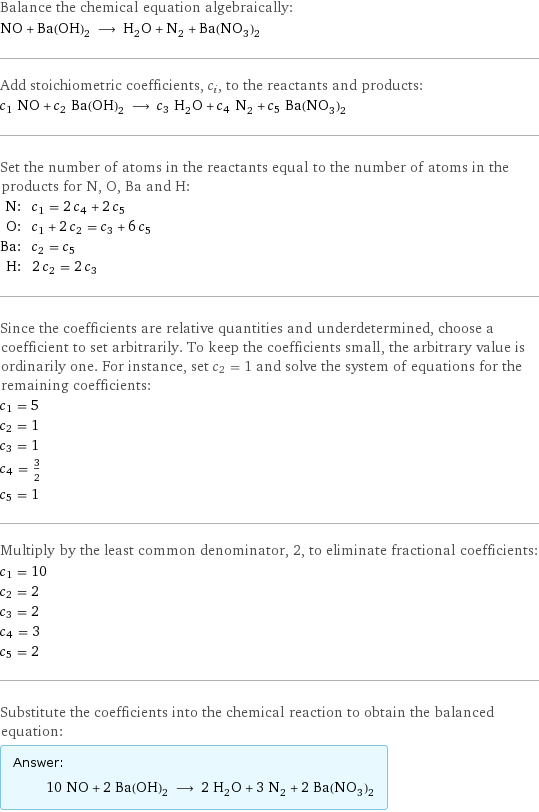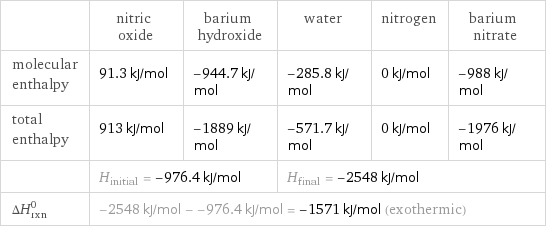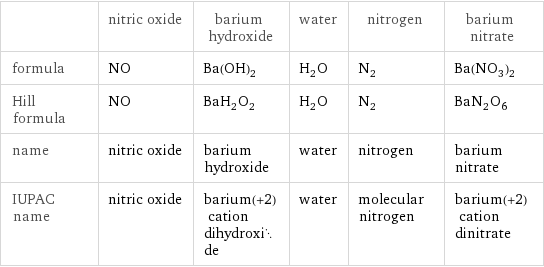Input interpretation

NO nitric oxide + Ba(OH)_2 barium hydroxide ⟶ H_2O water + N_2 nitrogen + Ba(NO_3)_2 barium nitrate
Balanced equation

Balance the chemical equation algebraically: NO + Ba(OH)_2 ⟶ H_2O + N_2 + Ba(NO_3)_2 Add stoichiometric coefficients, c_i, to the reactants and products: c_1 NO + c_2 Ba(OH)_2 ⟶ c_3 H_2O + c_4 N_2 + c_5 Ba(NO_3)_2 Set the number of atoms in the reactants equal to the number of atoms in the products for N, O, Ba and H: N: | c_1 = 2 c_4 + 2 c_5 O: | c_1 + 2 c_2 = c_3 + 6 c_5 Ba: | c_2 = c_5 H: | 2 c_2 = 2 c_3 Since the coefficients are relative quantities and underdetermined, choose a coefficient to set arbitrarily. To keep the coefficients small, the arbitrary value is ordinarily one. For instance, set c_2 = 1 and solve the system of equations for the remaining coefficients: c_1 = 5 c_2 = 1 c_3 = 1 c_4 = 3/2 c_5 = 1 Multiply by the least common denominator, 2, to eliminate fractional coefficients: c_1 = 10 c_2 = 2 c_3 = 2 c_4 = 3 c_5 = 2 Substitute the coefficients into the chemical reaction to obtain the balanced equation: Answer: | | 10 NO + 2 Ba(OH)_2 ⟶ 2 H_2O + 3 N_2 + 2 Ba(NO_3)_2
Structures

+ ⟶ + +
Names

nitric oxide + barium hydroxide ⟶ water + nitrogen + barium nitrate
Reaction thermodynamics
Enthalpy

| nitric oxide | barium hydroxide | water | nitrogen | barium nitrate molecular enthalpy | 91.3 kJ/mol | -944.7 kJ/mol | -285.8 kJ/mol | 0 kJ/mol | -988 kJ/mol total enthalpy | 913 kJ/mol | -1889 kJ/mol | -571.7 kJ/mol | 0 kJ/mol | -1976 kJ/mol | H_initial = -976.4 kJ/mol | | H_final = -2548 kJ/mol | | ΔH_rxn^0 | -2548 kJ/mol - -976.4 kJ/mol = -1571 kJ/mol (exothermic) | | | |
Equilibrium constant
![Construct the equilibrium constant, K, expression for: NO + Ba(OH)_2 ⟶ H_2O + N_2 + Ba(NO_3)_2 Plan: • Balance the chemical equation. • Determine the stoichiometric numbers. • Assemble the activity expression for each chemical species. • Use the activity expressions to build the equilibrium constant expression. Write the balanced chemical equation: 10 NO + 2 Ba(OH)_2 ⟶ 2 H_2O + 3 N_2 + 2 Ba(NO_3)_2 Assign stoichiometric numbers, ν_i, using the stoichiometric coefficients, c_i, from the balanced chemical equation in the following manner: ν_i = -c_i for reactants and ν_i = c_i for products: chemical species | c_i | ν_i NO | 10 | -10 Ba(OH)_2 | 2 | -2 H_2O | 2 | 2 N_2 | 3 | 3 Ba(NO_3)_2 | 2 | 2 Assemble the activity expressions accounting for the state of matter and ν_i: chemical species | c_i | ν_i | activity expression NO | 10 | -10 | ([NO])^(-10) Ba(OH)_2 | 2 | -2 | ([Ba(OH)2])^(-2) H_2O | 2 | 2 | ([H2O])^2 N_2 | 3 | 3 | ([N2])^3 Ba(NO_3)_2 | 2 | 2 | ([Ba(NO3)2])^2 The equilibrium constant symbol in the concentration basis is: K_c Mulitply the activity expressions to arrive at the K_c expression: Answer: | | K_c = ([NO])^(-10) ([Ba(OH)2])^(-2) ([H2O])^2 ([N2])^3 ([Ba(NO3)2])^2 = (([H2O])^2 ([N2])^3 ([Ba(NO3)2])^2)/(([NO])^10 ([Ba(OH)2])^2)](../image_source/908b416bc4b36712ac39b38600bfa6ea.png)
Construct the equilibrium constant, K, expression for: NO + Ba(OH)_2 ⟶ H_2O + N_2 + Ba(NO_3)_2 Plan: • Balance the chemical equation. • Determine the stoichiometric numbers. • Assemble the activity expression for each chemical species. • Use the activity expressions to build the equilibrium constant expression. Write the balanced chemical equation: 10 NO + 2 Ba(OH)_2 ⟶ 2 H_2O + 3 N_2 + 2 Ba(NO_3)_2 Assign stoichiometric numbers, ν_i, using the stoichiometric coefficients, c_i, from the balanced chemical equation in the following manner: ν_i = -c_i for reactants and ν_i = c_i for products: chemical species | c_i | ν_i NO | 10 | -10 Ba(OH)_2 | 2 | -2 H_2O | 2 | 2 N_2 | 3 | 3 Ba(NO_3)_2 | 2 | 2 Assemble the activity expressions accounting for the state of matter and ν_i: chemical species | c_i | ν_i | activity expression NO | 10 | -10 | ([NO])^(-10) Ba(OH)_2 | 2 | -2 | ([Ba(OH)2])^(-2) H_2O | 2 | 2 | ([H2O])^2 N_2 | 3 | 3 | ([N2])^3 Ba(NO_3)_2 | 2 | 2 | ([Ba(NO3)2])^2 The equilibrium constant symbol in the concentration basis is: K_c Mulitply the activity expressions to arrive at the K_c expression: Answer: | | K_c = ([NO])^(-10) ([Ba(OH)2])^(-2) ([H2O])^2 ([N2])^3 ([Ba(NO3)2])^2 = (([H2O])^2 ([N2])^3 ([Ba(NO3)2])^2)/(([NO])^10 ([Ba(OH)2])^2)
Rate of reaction
![Construct the rate of reaction expression for: NO + Ba(OH)_2 ⟶ H_2O + N_2 + Ba(NO_3)_2 Plan: • Balance the chemical equation. • Determine the stoichiometric numbers. • Assemble the rate term for each chemical species. • Write the rate of reaction expression. Write the balanced chemical equation: 10 NO + 2 Ba(OH)_2 ⟶ 2 H_2O + 3 N_2 + 2 Ba(NO_3)_2 Assign stoichiometric numbers, ν_i, using the stoichiometric coefficients, c_i, from the balanced chemical equation in the following manner: ν_i = -c_i for reactants and ν_i = c_i for products: chemical species | c_i | ν_i NO | 10 | -10 Ba(OH)_2 | 2 | -2 H_2O | 2 | 2 N_2 | 3 | 3 Ba(NO_3)_2 | 2 | 2 The rate term for each chemical species, B_i, is 1/ν_i(Δ[B_i])/(Δt) where [B_i] is the amount concentration and t is time: chemical species | c_i | ν_i | rate term NO | 10 | -10 | -1/10 (Δ[NO])/(Δt) Ba(OH)_2 | 2 | -2 | -1/2 (Δ[Ba(OH)2])/(Δt) H_2O | 2 | 2 | 1/2 (Δ[H2O])/(Δt) N_2 | 3 | 3 | 1/3 (Δ[N2])/(Δt) Ba(NO_3)_2 | 2 | 2 | 1/2 (Δ[Ba(NO3)2])/(Δt) (for infinitesimal rate of change, replace Δ with d) Set the rate terms equal to each other to arrive at the rate expression: Answer: | | rate = -1/10 (Δ[NO])/(Δt) = -1/2 (Δ[Ba(OH)2])/(Δt) = 1/2 (Δ[H2O])/(Δt) = 1/3 (Δ[N2])/(Δt) = 1/2 (Δ[Ba(NO3)2])/(Δt) (assuming constant volume and no accumulation of intermediates or side products)](../image_source/93496848bc3c0ccd20e29416f657879a.png)
Construct the rate of reaction expression for: NO + Ba(OH)_2 ⟶ H_2O + N_2 + Ba(NO_3)_2 Plan: • Balance the chemical equation. • Determine the stoichiometric numbers. • Assemble the rate term for each chemical species. • Write the rate of reaction expression. Write the balanced chemical equation: 10 NO + 2 Ba(OH)_2 ⟶ 2 H_2O + 3 N_2 + 2 Ba(NO_3)_2 Assign stoichiometric numbers, ν_i, using the stoichiometric coefficients, c_i, from the balanced chemical equation in the following manner: ν_i = -c_i for reactants and ν_i = c_i for products: chemical species | c_i | ν_i NO | 10 | -10 Ba(OH)_2 | 2 | -2 H_2O | 2 | 2 N_2 | 3 | 3 Ba(NO_3)_2 | 2 | 2 The rate term for each chemical species, B_i, is 1/ν_i(Δ[B_i])/(Δt) where [B_i] is the amount concentration and t is time: chemical species | c_i | ν_i | rate term NO | 10 | -10 | -1/10 (Δ[NO])/(Δt) Ba(OH)_2 | 2 | -2 | -1/2 (Δ[Ba(OH)2])/(Δt) H_2O | 2 | 2 | 1/2 (Δ[H2O])/(Δt) N_2 | 3 | 3 | 1/3 (Δ[N2])/(Δt) Ba(NO_3)_2 | 2 | 2 | 1/2 (Δ[Ba(NO3)2])/(Δt) (for infinitesimal rate of change, replace Δ with d) Set the rate terms equal to each other to arrive at the rate expression: Answer: | | rate = -1/10 (Δ[NO])/(Δt) = -1/2 (Δ[Ba(OH)2])/(Δt) = 1/2 (Δ[H2O])/(Δt) = 1/3 (Δ[N2])/(Δt) = 1/2 (Δ[Ba(NO3)2])/(Δt) (assuming constant volume and no accumulation of intermediates or side products)
Chemical names and formulas

| nitric oxide | barium hydroxide | water | nitrogen | barium nitrate formula | NO | Ba(OH)_2 | H_2O | N_2 | Ba(NO_3)_2 Hill formula | NO | BaH_2O_2 | H_2O | N_2 | BaN_2O_6 name | nitric oxide | barium hydroxide | water | nitrogen | barium nitrate IUPAC name | nitric oxide | barium(+2) cation dihydroxide | water | molecular nitrogen | barium(+2) cation dinitrate